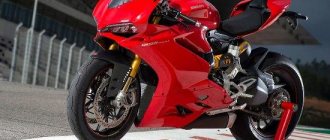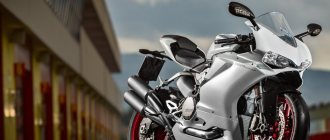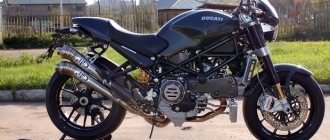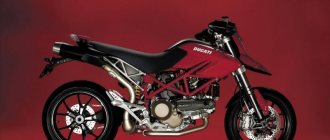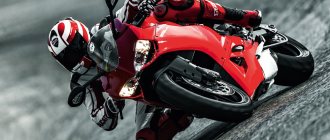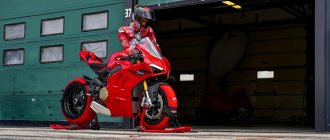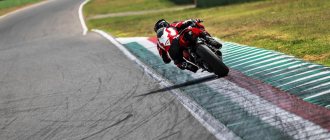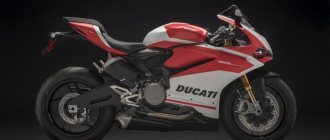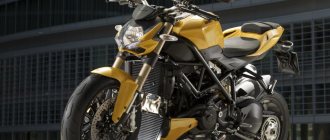When the newest Ducati 1199 Panigale hyperbike was presented to the public in 2012, it immediately became clear to everyone: no one would be able to move this bright red guy off the pedestal for a long time. At the cost of a long and unprecedentedly thorough development, this motorcycle embodied all the technical achievements of Italian engineers and designers. Armed with the company's experience in road racing, they have essentially unleashed on public roads an unimaginably powerful sports machine designed for the track, not the city streets. And externally, the new product did not leave anyone indifferent, and jokes about “ Panigale effect“, when on the street everyone turns their heads after this brainchild of Ducati, growling its muffler solidly. But there is also a Ducati 1199 Panigale S! A little more perfect and stylish, but just as powerful and impressive in every way.
For the unique appearance of the Ducati Panigale 1199, we should thank Gianandrea Fabbro , one of the oldest Ducati designers - it was he who came up with the very concept of this motorcycle, and he made the first sketches back in 2006. According to him, he did this for fun, trying to create an image of a motorcycle that was at the same time ultra-modern, beautiful, and somewhat unusual. It is to him that the Ducati 1199 Panigale owes its non-standard layout for sportbikes of this brand. Fans of Ducati will immediately notice, for example, the absence of a “birdcage” - the engine is bashfully tucked away inside a plastic body kit. Having sat on this motorcycle, you can be surprised to notice that, despite its impressive technical characteristics, it is even more compact compared to the younger Ducati models. But first things first!
000_moto_0112_010
Compared to last year's Ducati 1198, the new Panigale is 10 kg lighter and 25 hp more powerful.
Compared to last year's Ducati 1198, the new Panigale is 10 kg lighter and 25 hp more powerful.
They say that when the Japanese first saw the “shishiga” (GAZ-66), they clicked their tongues for a long time and groaned in admiration: “Whatever the Russians can come up with, just so as not to build roads!” Studying the design of the Ducati 1199 Panigale, I want to repeat after them: “Whatever the Italians can come up with, just so as not to switch to four cylinders!” It's scary to think how Ducati would crush its rivals if it released a four-cylinder motorcycle. But it worked out well with two. How long have we admired the 1:1 power ratio? And the Panigale has 195 hp. power for 165 kg of dry weight! And even equipped - only 188 kg.
In their L-twins, Ducati specialists consistently used all possible overhead camshaft drive schemes: first with shafts and bevel gears, then with a belt, and now they have finally switched to the generally accepted chain drive scheme. Well, the headaches for mechanics will clearly be reduced (by the way, the stated service intervals are 24,000 km). Another revolutionary change in engine design was the transition from roller main bearings to plain bearings: this solution made it possible to increase the size of the crankshaft journals without “inflating” the crankcase.
So Ducati experts are not lying when they say that all that remains from the previous engines in the new Superquadro is a desmodromic valve drive and an L-shaped cylinder arrangement with a camber angle of 90º. However, L is already conditional: in an effort to move the power unit forward and thereby load the front wheel, the engineers “twisted” it back, so that the front cylinder rose 21º from the horizontal. The classic V is not too far away! Weight distribution with a driver of average fatness - 52/48%.
Another fundamental innovation is reflected in the very name of the engine: Superquadro, “super square”. The dimensions of the unit are 112x60.8 mm (for comparison, the previous 1198 had 106x67.9 mm). The large cylinder diameter made it possible to increase the valve sizes: intake from 43.5 to 46.8 mm, exhaust from 34.5 to 38.2 mm. To reduce the mass of these “plates”, we had to switch to a titanium alloy. Well, the desmodromic drive turned out to be just right. The engine design uses a centrifugal decompressor to facilitate starting, the mechanism of which is built into the exhaust camshafts, and a vacuum pump in the crankcase. It sits on the same shaft as the oil pump and creates a vacuum in the cavity under the pistons, reducing pneumatic losses (a solution widely used in MotoGP engines). The cylinders are cast integrally with the crankcase parts; “wet” aluminum liners with nickasil coating are inserted into them (this solution increases the rigidity of the unit, improves sealing and heat dissipation).
For the first time on Ducati superbikes, the transmission has abandoned the dry clutch. Now it works in an oil bath, and a mechanism known from Monster is used: when the speed increases, the discs are additionally pressed against each other, which allows the springs to be slightly weakened and thereby reduce the squeezing force.
The power unit is the main load-bearing element of the chassis. Attached to the cylinder heads is what remains of the frame - a cast aluminum monocoque, which also serves as an air filter housing. Connected to this is a magnesium alloy front subframe that holds the fairing, headlights and instrument panel. The axis of the rear suspension pendulum passes through the crankcase of the power unit. The horizontal monoshock absorber is shifted to the side - this way the designers not only freed up space for the rear cylinder of the engine, but also provided easy access to the settings. By rearranging the mounting points, you can change the degree of suspension progression - from maximum for riding with a passenger to linear for track rides.
In terms of electronics, the Ducati Panigale leaves all other sportbikes far behind. Firstly, there is eight-position DTC traction control - its switch is located at the left handlebar grip. Secondly, the DQS quick shifter allows you to shift up without releasing the gas. Thirdly, the EBC electronic engine braking control system - by analyzing sensor data, it prevents the throttle valves from being completely closed if there is a threat of locking the rear wheel (interestingly, it works in conjunction with a slipper clutch). Fourthly, ABS. Fifthly, the DDA+ data collection system, which is now equipped with a GPS sensor: on the track you just need to press the “flashing light” button on the start-finish line once for the system to count the laps itself. Sixthly, DES suspensions with electronic hydraulic adjustments. Finally, there is a mode switch that affects not only the engine, but all the electronic systems of the motorcycle - just like on the Ducati Multistrada. In Race mode, there is the most acute response to the movement of the throttle, the suspension is “clamped”, the racing settings of the engine braking system are turned on, ABS affects only the front wheel, and the appearance of the instrument panel changes. In Sport mode, the response to the throttle is smoothed out, the suspension and engine braking system switch to a softer mode, the intervention of the traction control system increases, ABS acts on two wheels and combats the lift of the rear wheel during heavy braking. In Wet mode, the maximum power is reduced to 120 hp, the throttle response is the smoothest, the suspension settings are optimized for poor grip, the quick shifter is disabled, traction control, engine braking control and ABS work "to the fullest." However, the driver himself can get into the settings menu for all systems (the display is a dashboard on TFT thin-film transistors) and configure the mode to his own taste.
The Ducati Panigale is available in three equipment variants. The base model has fully adjustable suspension (Marzocchi front fork and Sachs rear monoshock), but with manual adjustments. ABS and the DDA+ data acquisition system are installed at an additional cost. The Panigale S version is equipped with electronically adjustable suspension: Ohlins NIX30 front fork and Ohlins TTX36 rear monoshock. In addition, this version differs from the base version with LED headlights, forged Marchesini wheels and a carbon fiber front fender. On the top version of the Panigale S Tricolore, painted in the colors of the Italian flag, all options, including ABS and DDA+, are included in the equipment. In addition, the machine is equipped with an exhaust system made of titanium alloy.
How much does all this splendor cost? In Italy, the base Panigale costs 19,190 euros, the S version costs 23,990 euros, and the Panigale S Tricolore costs 28,990 euros. That is, the new family is 10–15% more expensive than the discontinued “1198”. The price ratio in our market will be approximately the same.
Similar models
- Aprilia Tuono Vr 1100RR . Another racing Italian, stylish and technically advanced.
- BMW S1000RR . The quintessential Bavarian hyperbike.
- Suzuki GSX-R1000 . One of the most popular liter sportbikes.
- Yamaha YZF-R1. An angry, light, tough, not very comfortable and monstrously powerful Japanese.
- Kawasaki Ninja H2. The most powerful hyperbike in the world, and that says it all.
016_moto_0112_010
Visitors to the Milan Motor Show EICMA-2011 named the Ducati Panigale the most beautiful motorcycle of the exhibition.
Visitors to the Milan Motor Show EICMA-2011 named the Ducati Panigale the most beautiful motorcycle of the exhibition.
| TECHNICAL SPECIFICATIONS Ducati 1199 Panigale (manufacturer data) | |||
| Model | 1199 Panigale | 1199 Panigale S | 1199 Panigale S Tricolore |
| COMMON DATA | |||
| Model year | 2012 | ||
| Curb weight, kg | 188 | 190,5 | |
| Length, mm | 2075 | ||
| Base, mm | 1437 | ||
| Seat height, mm | 825 | ||
| Reach, mm | 100 | ||
| Steering column tilt angle, degrees. | 24,5 | ||
| Gas tank volume, l | 17 | ||
| ENGINE | |||
| Type | V2, 4T | ||
| timing belt | DOHC, 4 valves per cylinder | ||
| Working volume, cm³ | 1198 | ||
| Cylinder diameter × piston stroke, mm | 112×60,8 | ||
| Compression ratio | 12,5:1 | ||
| Max. power, hp at rpm | 195/10750 | ||
| Max. torque, Nm at rpm | 132/9000 | ||
| Supply system | fuel injection, two injectors per cylinder | ||
| Cooling system | liquid | ||
| Starting system | electric starter | ||
| TRANSMISSION | |||
| Clutch | multi-disc, oil bath, with reverse slip | ||
| Transmission | 6-speed | ||
| main gear | chain | ||
| CHASSIS | |||
| Frame | monocoque, aluminum alloy | ||
| Front suspension | Marzocchi inverted telescopic fork, fully adjustable | Ohlins inverted telescopic fork, fully adjustable, electronic hydraulic adjustments | |
| Pipe diameter, mm | 50 | 43 | |
| Wheel travel, mm | 120 | ||
| Rear suspension | pendulum, with progressive characteristics and fully adjustable Sachs monoshock absorber | pendulum, with progressive characteristics and fully adjustable Ohlins monoshock absorber, electronic hydraulic adjustments | |
| Wheel travel, mm | 130 | ||
| Brake system | separate, hydraulic, optional - with ABS | separate, hydraulic, with ABS | |
| Front brake | two Ø 330 mm discs, monobloc 4-piston Brembo M50 calipers | ||
| Rear brake | disc Ø 245 mm, 2-piston caliper | ||
| Wheels | cast, aluminum alloy | ||
| Front tire | 120/70ZR17 | ||
| Rear tire | 200/55ZR17 | ||
PA-NI-GA-LI: Ducati 1199 Panigale
Reviews from Ducati 1199 Panigale owners
This is not a motorcycle, but an adrenaline machine. Dear, yes, every sneeze costs a penny, but for SUCH pleasure you don’t mind spending any money. It’s inconvenient, after half an hour of riding in overalls the fried eggs start to fry in your pants, you won’t be able to ride for a long time. The clip-ons are unusually wide and close, your back ache and your arms get tired. But I’ll still have time to buy Gold in my old age, but for now I’d rather enjoy the best motorcycle ever produced in this world. Grigory, Moscow, Ducati 1199 Panigale '2013.
I took a bike from the USA to order, after the recall campaign that took place there, I wouldn’t take an older bike, there are a lot of jambs there - the pendulums spin up while moving, the steering damper lives its own life, the wiring is on fire, and there are a bunch of other jambs. But after the recall, you can trust the motorcycle, I mostly ride on the track, I covered a little more than 4,000 kilometers in a season, there were no problems, only once the bike swallowed questionable gasoline, I had to flush the injector and synchronize it again. The bike is a rocket, it doesn’t move, but flies over the road. It gets too hot, but it’s tolerable at speed, but when you drive in the city, you slowly bake, and your hands on the steering wheel fall off from the vibrations. Dmitry, Moscow, Ducati 1199 Panigale '2017.
In the garage there is a BMW S1000RR and a Panigale 1199 S, if you compare them with each other, the BMW is definitely more convenient for the city, but on the track the Ducati is head and shoulders better. Where you have to slow down on a BMW, you can still accelerate on a Panigal, the brakes are just hell, in a good way. Controlled by the power of thought at any speed, other Europeans and Japanese never even dreamed of it. I still drive the Bavarian more often, because an hour and a half ride on the Dukas makes you incredibly tired, but the toy is simply fierce, I have never regretted what I bought. Sergey, Rostov-on-Don, Ducati 1199 Panigale '2014.
Features of the chassis and their design
Another feature of the motorcycle is the radically new approach that was used when creating the body. The developers abandoned the “birdcage” frame, but this spatial frame was traditional for the company.
For the updated design, monocoque technology was proposed. The engine and the suspension units attached to it became the supporting element used for all used components. Also, a lightweight external frame made of aluminum was attached to the engine as a supporting element. This frame ties together two parts of the motorcycle, that is, the front part and also the rear part.
Both the rear and front suspensions are adjustable. Up front is a 50mm fork with 120mm of travel. The fork angle is 24 degrees and 50 minutes. As for the rear suspension, it is equipped with a pendulum. This pendulum is attached directly to the engine. Suspension travel is as much as 130 millimeters.
There are 10 spokes on the wheels. The front wheel measures 3.5 by 17 inches, and the rear wheel measures 6 by 17 inches. The front wheel has 120/70 high-speed tires, and the rear wheel has 200/55. Both tires are the same model – Pirelli Diablo Supercorsa SP.
Ducati Panigale R
Price
But how much exactly does this Ducati 1199 Superleggera motorbike cost? In Italy, the basic model of this monster will cost a person 19 thousand euros, and the S version – 24 thousand euros. There is also a more expensive version - this is the S Tricolore. It costs 29 thousand euros.
This means that the new family of motorcycles will be 15 percent more expensive than the already discontinued 1198. The cost ratio on the market will be approximately the same.
Ducati Panigale
Post Views: 5,393
